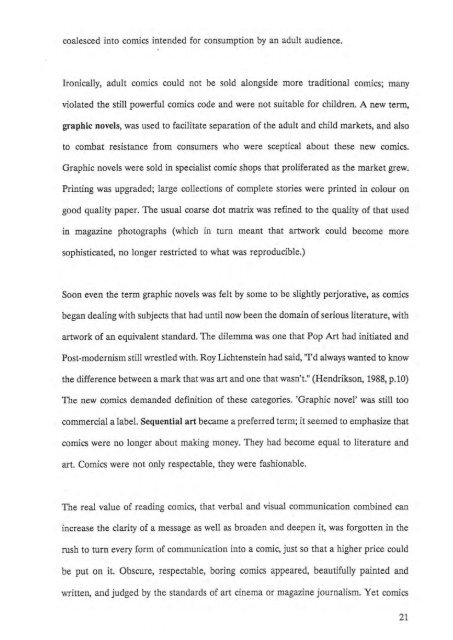Text - Rhodes University
Text - Rhodes University
Text - Rhodes University
You also want an ePaper? Increase the reach of your titles
YUMPU automatically turns print PDFs into web optimized ePapers that Google loves.
coalesced into comics intended for consumption by an adult audience.<br />
Ironically, adult cornics could not be sold alongside more traditional cornics; many<br />
violated the still powerful cornics code and were not suitable for children. A new term,<br />
graphic novels, was used to facilitate separation of the adult and child markets, and also<br />
to combat resistance from consumers who were sceptical about these new cornics.<br />
Graphic novels were sold in specialist cornic shops that proliferated as the market grew.<br />
Printing was upgraded; large collections of complete stories were printed in colour on<br />
good quality paper. The usual coarse dot matrix was refined to the quality of that used<br />
in magazine photographs (which in turn meant that artwork could become more<br />
sophisticated, no longer restricted to what was reproducible.)<br />
Soon even the term graphic novels was felt by some to be slightly perjorative, as cornics<br />
began dealing with subjects that had until now been the domain of serious literature, with<br />
artwork of an equivalent standard. The dilemma was one that Pop Art had initiated and<br />
Post-modernism still wrestled with. Roy Lichtenstein had said, "I'd always wanted to know<br />
the difference between a mark that was art and one that wasn't." (Hendrikson, 1988, p.lO)<br />
The new cornics demanded definition of these categories. 'Graphic novel' was still too<br />
commercial a label. Sequential art became a preferred term; it seemed to emphasize that<br />
cornics were no longer about making money. They had become equal to literature and<br />
art. Cornics were not only respectable, they were fashionable.<br />
The real value of reading cornics, that verbal and visual communication combined can<br />
increase the clarity of a message as well as broaden and deepen it, was forgotten in the<br />
rush to turn every form of communication into a cornic, just so that a higher price could<br />
be put on it. Obscure, respectable, boring carnics appeared, beautifully painted and<br />
written, and judged by the standards of art cinema or magazine journalism. Yet carnics<br />
21
















